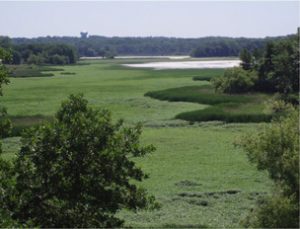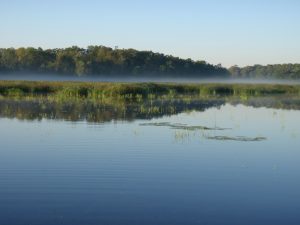Eden Prairie
ABOUT
In the fall of 2008, the District completed a drawdown project on Northwest and Southwest Anderson Lakes to address excess phosphorus levels and curly-leaf pondweed, an invasive aquatic plant. The intent of the project was to expose the lake bottom to freeze and kill the turions (seed) of the curly-leaf pondweed.
Project Details
 The removal of stop logs began draining the lakes by gravity in August 2008. Pumps drained the lakes from September to November of 2008, achieving a partial drawdown. The District partnered with the University of Minnesota to study the density and viability of the turion bank in the lake sediment. Lake sediment samples were collected in Northwest, Southwest, and Southeast Anderson Lakes.
The removal of stop logs began draining the lakes by gravity in August 2008. Pumps drained the lakes from September to November of 2008, achieving a partial drawdown. The District partnered with the University of Minnesota to study the density and viability of the turion bank in the lake sediment. Lake sediment samples were collected in Northwest, Southwest, and Southeast Anderson Lakes.
The restoration of the water levels in the lakes post-drawdown was significantly slowed due to drought conditions through the summer of 2009. The water levels on Northwest and Southwest Anderson Lake were fully recovered by 2013.
The District and Three Rivers Park District has routinely monitored vegetation in lakes to determine if curly-leaf pondweed is still present. It was determined through visual observation
that the areas of both lakes that were not completely drained still had curly-leaf pondweed. The eastern bay of Northwest Anderson was chemically treated with Endothal-K from 2010 to 2013. The central area of Southwest Anderson was chemically treated in 2010 and 2011.
This project was part of the larger Eden Prairie Lakes Water Quality Improvement Project.
Anderson Lakes Curly Leaf Pondweed Control Fact Sheet (PDF)
Eden Prairie Lakes Water Quality Improvement Project Engineer’s Report (PDF)
Water Quality Impact
 Monitoring activities in 2013 and 2014 showed a dramatic reduction of curly-leaf pondweed in Northwest and Southwest Anderson Lakes. Along with the reduction of curly-leaf pondweed was an increase in the abundance of native aquatic plants. Monitoring results showed the presence of 34 native aquatic plant species in Northwest Anderson Lake. The District continues to monitor the water quality of the lakes.
Monitoring activities in 2013 and 2014 showed a dramatic reduction of curly-leaf pondweed in Northwest and Southwest Anderson Lakes. Along with the reduction of curly-leaf pondweed was an increase in the abundance of native aquatic plants. Monitoring results showed the presence of 34 native aquatic plant species in Northwest Anderson Lake. The District continues to monitor the water quality of the lakes.
Water quality monitoring showed a significant improvement in Northwest Anderson Lake, due to the decreased abundance of curly-leaf pondweed and the increased abundance of native aquatic plants.
However, water quality declined in Southwest Anderson Lake. The decline of water quality in Southwest Anderson Lake is attributed to the shallow nature of the lake, the rich organic nature of the lake substrate, and the lack of aquatic vegetation. To reduce the amount of phosphorus in the lake, an alum treatment was done in 2012. This treatment improved water quality in Southwest Anderson Lake.
